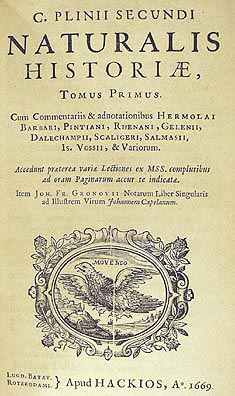Pliny the Elder
Gaius Plinius Secundus (23 AD – 25 August 79 AD), better known as Pliny the Elder, was a Roman author, naturalist, and natural philosopher, as well as naval and army commander of the early Roman Empire, and personal friend of the emperor Vespasian.
Pliny the Elder or Gaius Plinius Secundus | |
|---|---|
 Pliny the Elder: an imaginative 19th century portrait. No contemporary depiction of Pliny has survived. | |
| Born | 23 AD |
| Died | August 25, 79 (aged 55–56) |
| Cause of death | Died in the eruption that destroyed Pompeii |
| Body discovered | By friends, under the pumice |
| Citizenship | Roman |
| Education | Rhetoric, grammar |
| Occupation(s) | Lawyer, author, natural philosopher, military commander, provincial governor |
| Notable work | Natural History |
| Spouse | None |
| Children | None |
| Parent(s) | Celer and Marcella |
| Relatives | Sister (Plinia), nephew (Pliny the Younger) |

Spending most of his spare time studying, writing or investigating natural and geographic phenomena in the field, he wrote an encyclopedic work, Natural History ("Naturalis Historia"), which became a model for many subsequent encyclopedic texts.
Pliny the Elder died on 25 August 79 AD. He was attempting the rescue by ship of a friend and his family from the eruption of Mount Vesuvius. The eruption had just destroyed the cities of Pompeii and Herculaneum.
Pliny's Natural History
changeThe Naturalis Historia is one of the largest works on natural history to have survived from the Roman Empire to the modern day. It claims to cover the entire field of ancient knowledge, based on the best authorities available to Pliny. He claims to be the only Roman ever to have undertaken such a work. It includes the fields of botany, zoology, astronomy, geology and mineralogy as well as the exploitation of those resources. It remains a standard work for the Roman period and the advances in technology and understanding of natural phenomena at the time.
Some technical advances he discusses are the only sources for those inventions, such as hushing in mining technology or the use of water mills for crushing or grinding grain. Much of what he wrote about has been confirmed by archaeology. It is virtually the only work which describes the work of artists of the time, and is a reference work for the history of art.
The work became a model for all later encyclopedias in the breadth of subject matter examined, the need to reference original authors, and a comprehensive index list of the contents. The work is dedicated to the emperor Titus, son of Pliny's close friend, the emperor Vespasian, in the first year of Titus' reign. It is the only work by Pliny to have survived, and the last that he published, lacking a final revision at his sudden and unexpected death in the AD 79 eruption of Vesuvius.
The Natural History consists of 37 books. Pliny devised his own table of contents. The table below is a summary based on modern names for topics.
| I | Preface and tables of contents, lists of authorities |
| II | Mathematical and physical description of the world |
| III–VI | Geography and ethnography |
| VII | Anthropology and human physiology |
| VIII–XI | Zoology |
| XII–XXVII | Botany, including agriculture, horticulture and pharmacology |
| XXVIII–XXXII | Pharmacology |
| XXXIII–XXXVII | Mining and mineralogy, especially in its application to life and art, including: gold casting in silver[1] statuary in bronze[2] painting[3] modelling [4] sculpture in marble[5] precious stones and gems[6] |